CCTV means Closed-Circuit Television, and it has become an essential tool used for bolstering security. Its primary function is to monitor and record in homes and businesses privately, which helps prevent crimes and provides valuable video footage that can be used by law enforcement after a crime has taken place. In this article, we’ll define CCTV, discuss how it works and highlight the benefits this technology can provide.
Key Points
- CCTV technology is a surveillance tool that can help deter crime.
- Modern CCTV systems have various types of cameras, such as analog and IP, and can include features such as remote monitoring, motion detection, night vision and now even AI powered features.
- While it’s been proven to reduce crime and help with investigations, CCTV systems also have challenges such as privacy concerns, high installation costs and technical issues.
Understanding CCTV Technology
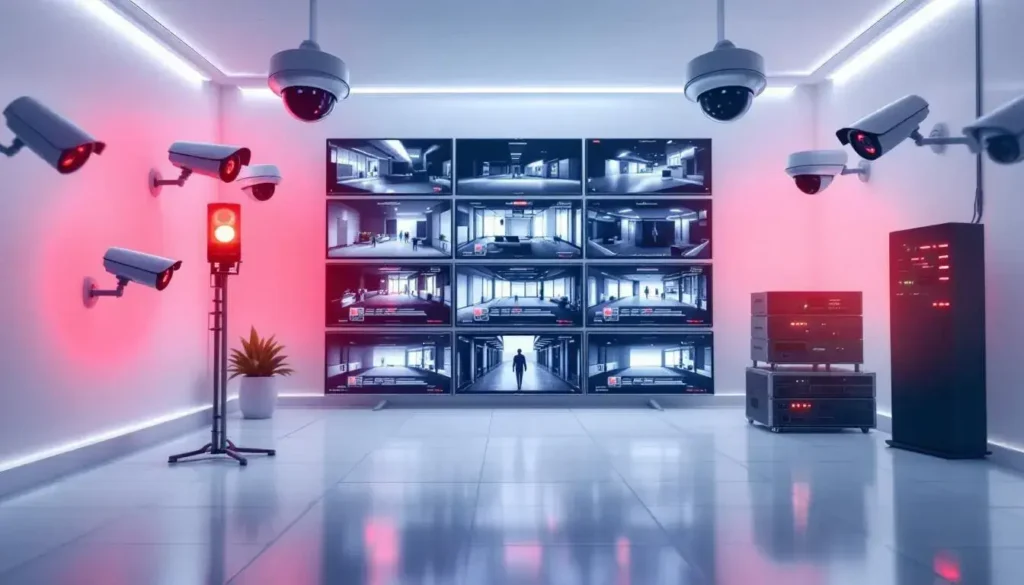
CCTV is the backbone of modern security systems, offering homes and businesses the ability to monitor and record what’s happening in certain areas. This not only helps increase security for property owners but also gives them peace of mind. Over the years, CCTV technology has evolved, making security cameras better and more reliable, which has in turn made it more accessible to people and companies. CCTV equipment refers to a range of hardware and digital tools—cameras, recorders, network devices— and is used in surveillance systems in a wide range of locations such as industrial sites, public spaces and law enforcement.
What does CCTV Stand For?
CCTV refers to a system that has video cameras sending signals to a specific set of monitors. Unlike broadcast television, CCTV is a self-contained system where the video signals are not broadcast but instead monitored for surveillance and security purposes. The main purpose of CCTV surveillance is to deter crime and gather evidence for the police. Because they capture and record in real time, these systems play a significant role in crime prevention and investigative support. For example, police often use CCTV video to aid investigations and gather evidence for the court. CCTV cameras also help to deter potential criminals because they know that their actions will be recorded.
The History of CCTV
CCTV emerged in the late 1920s and into the early 1940s as a simple mechanical system. In 1939, the first CCTV system was publicly demonstrated at the New York World’s Fair, showing its use for monitoring and surveillance. In 1942, the technology was first used for military purposes, where it was used to effectively observe rocket launches.
Since that time, CCTV has evolved significantly, transforming from a basic mechanical system into an advanced digital surveillance solution. The continuous development and integration of new technologies have made modern CCTV systems more efficient and versatile for various security needs across many different industries.
How CCTV Systems Work
CCTV systems are designed to facilitate effective surveillance by utilizing technology to monitor and record activities in various environments. At the core of every CCTV system are essential components, including a CCTV camera, monitor and video recorder that work together to capture and store video footage as part of a video surveillance system. CCTV systems can also transmit data to other entities, such as traffic management centers or law enforcement, for purposes such as traffic monitoring and incident response.
Knowing how these core components interact and the differences between analog or digital CCTV systems can help business and other property owners select the right system for their particular needs. Whether they are considering an analog system with a digital video recorder (DVR) or a more advanced digital system with an IP camera and network video recorder (NVR), knowing these basics can help anyone make more informed purchasing decisions.
Components of CCTV Systems
CCTV systems use two types of cameras: analog and IP (network) cameras. Analog cameras are designed to work with DVR systems for video recording, while IP cameras have network connectivity and higher resolution video. IP cameras are advanced surveillance devices that transmit digital video over networks, support remote access and integrate with network video recorders using standard protocols such as ONVIF. These cameras can have CMOS or CCD image sensors, which affect the video quality.
Video encoders convert analog footage into a digital format for network systems so it can be easily stored and retrieved. DVRs compress, convert and store video from analog cameras, while NVRs do the same for IP cameras. This allows both types of cameras to perform remote monitoring and management with recording devices.
Power over Ethernet (PoE) makes the installation and operation of CCTV systems easier by sending power and data through one cable. This reduces the need for extensive wiring and makes it more efficient for electric and electronics engineers.
Analog vs. Digital CCTV Systems
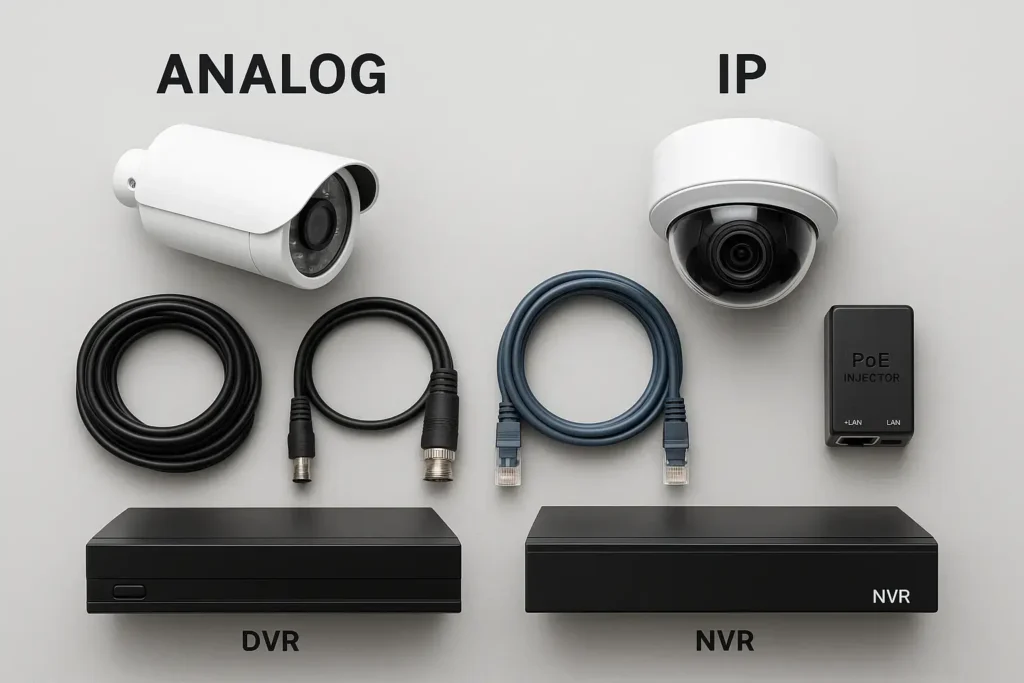
The introduction of digital technology in the late 1990s brought a huge improvement in image quality and storage for CCTV systems. Digital CCTV systems enable higher resolution video quality compared to analog, making them more effective for detailed surveillance. High-definition video became common with the introduction of IP cameras, digital cameras, digital video cameras and video images, which spurred a new era in CCTV technology.
Installation of digital CCTV systems became simpler with the introduction of technologies such as Power over Ethernet (PoE), which reduces the need for multiple cables. This simplicity, combined with the better image quality, propelled digital systems to become the first choice for modern surveillance.
Networking and Connectivity
Networking and connectivity are at the heart of modern CCTV systems, transforming how security cameras operate and how property owners interact with their surveillance setups. With the rise of IP cameras, video signals were able to transmit over a network, allowing for seamless integration with NVRs and DVRs. This network-based transmission enables centralized management of multiple cameras, remote access to live and recorded footage and easier scalability for expanding surveillance coverage.
IP cameras leverage standard network infrastructure, often using PoE technology to transmit both power and data through a single cable for simplifying installation and reducing wiring costs. The ability to transmit video feeds over local area networks (LANs) or even the internet allows users to monitor their CCTV systems from virtually anywhere using computers or mobile devices.
Networking also facilitates advanced features such as video analytics, motion detection alerts and integration with other security systems. In addition, video servers and video capture cards are often employed to convert and manage video streams, enabling compatibility between analog cameras and digital networks.
Advancements in networking and connectivity have revolutionized CCTV technology by providing more flexibility, accessibility and functionality. This, in turn, has made modern CCTV systems more effective and user-friendly.
Types of CCTV Cameras
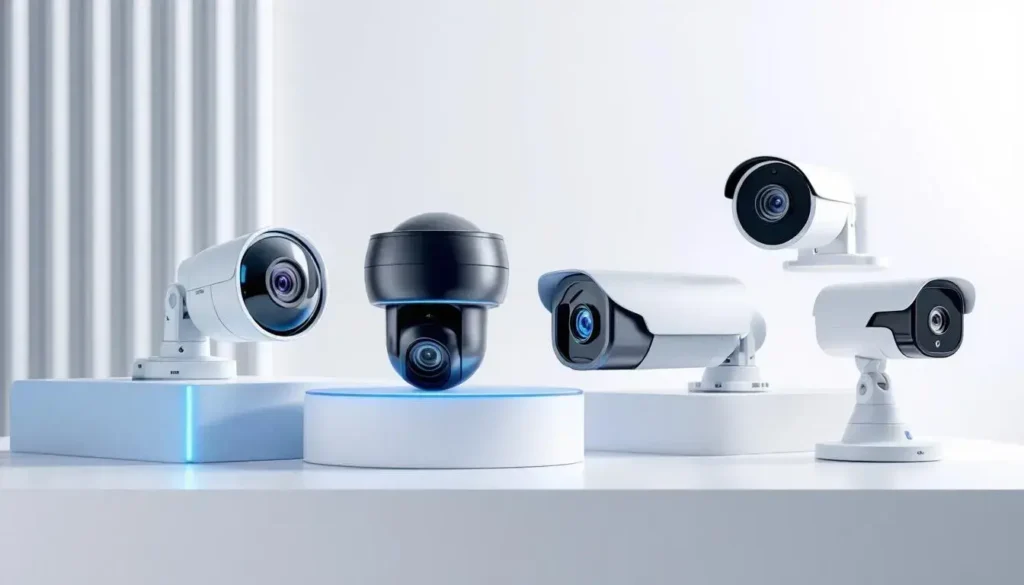
CCTV systems can include a variety of camera types, each designed to meet the specific surveillance needs of a property or business. Users can choose from dome cameras, bullet cameras and IP cameras. Wireless cameras have also become popular and offer easy installation, digital connectivity and flexible placement options, which make them ideal for home and small business surveillance. Each type of camera offers unique features and benefits, making them suitable for a wide variety of applications.
Whether a company or property owner needs a camera for discreet indoor monitoring, long-distance outdoor surveillance or high-resolution video capture, understanding the characteristics of each type will help them choose the right camera for their security needs.
Dome Cameras
Dome cameras often have the following features:
- Vandal-resistant casings for high-traffic areas like hallways in schools or apartments.
- Infrared night vision for clear images in low light.
- Compact and sleek design to blend in with any environment.
Many dome cameras also feature a varifocal lens, allowing the field of view to be adjusted for optimal coverage. These cameras can also be categorized as either PTZ (pan-tilt-zoom), outdoor, PoE or 4K, each of which is designed for a specific surveillance need.
Bullet Cameras
Bullet cameras are used for long-distance viewing, such as outdoor surveillance. They are effective at monitoring large areas such as parking lots and building perimeters. Analog bullet cameras transmit video over coaxial cables for a reliable video feed.
IP Cameras
IP cameras have the following advantages over analog cameras:
- Higher-resolution images, ranging from 1.3 to 5 megapixels, for flexibility and scalability with advanced image sensor technology.
- The ability to compress, convert and stream video over the internet for remote access and management.
- Easier setup and lower costs due to the fact that it does not require a DVR.
Remote access and management of IP cameras make them a popular choice for modern surveillance systems. Whether for home security or business surveillance, IP cameras provide high-quality video and flexibility to help monitor both outside and inside a facility.
Applications of CCTV Systems
CCTV systems have provided multiple applications in both residential and commercial properties. The main purpose of CCTV cameras in all applications is real-time monitoring and recording, and these can be used for:
- Public buildings
- Private offices
- Residential homes
- Traffic management
Integration of other technologies with CCTV systems, such as facial recognition and IoT, further enhances their capabilities and can enable passive surveillance and alert-raising functionality. These systems can also be used for mass surveillance, where large-scale monitoring of public spaces is possible with the deployment of security cameras and digital technologies located in strategic places throughout a facility.
Home Security
CCTV systems are used in residential areas to deter crime and assist the police with evidence after a crime has been committed. Just the presence of security cameras can reduce the chances of burglary or vandalism. Monitoring stations allow home users to view and manage surveillance footage in real-time, so they can monitor assets from anywhere. They may also include motion detection and alert notifications that further increase home safety.
Home security systems that use high-quality cameras can capture clearer recordings that can be used as evidence and to identify suspects.
Business Surveillance
Businesses use CCTV for several reasons, including crime deterrence, employee monitoring, protecting cash and preventing shoplifting and vandalism. For example, retail stores use CCTV systems to deter or catch shoplifters and monitor employee actions in the store.
The emergence of cloud-based solutions has made business surveillance even more accessible and useful, and can include automatic updates so businesses can use the latest technology as part of their business security solution toolset.
Traffic Monitoring
Traffic management centers use CCTV cameras to analyze traffic patterns and detect incidents. These cameras play an important role in traffic monitoring and road safety and can help provide a quicker response to accidents. The integration of CCTV technology provides better road safety outcomes by delivering real-time data for traffic management.
CCTV not only helps manage traffic better, but it can also result in smoother traffic flow and safer roads. Traffic can be monitored in real-time to help traffic management center employees make quick decisions and provide better incident management.
Modern CCTV System Features in 2025
Modern CCTV systems have many advanced features that make them more functional and effective over time. This includes features such as remote management, motion detection alerts and HD video from 1080p to 4K. These features provide clearer and more detailed footage so homes and businesses can monitor and record easily.
In addition, data storage included in CCTV systems is designed to handle continuous video feeds from multiple cameras, so all footage is stored securely and can be retrieved when needed.
Remote Monitoring
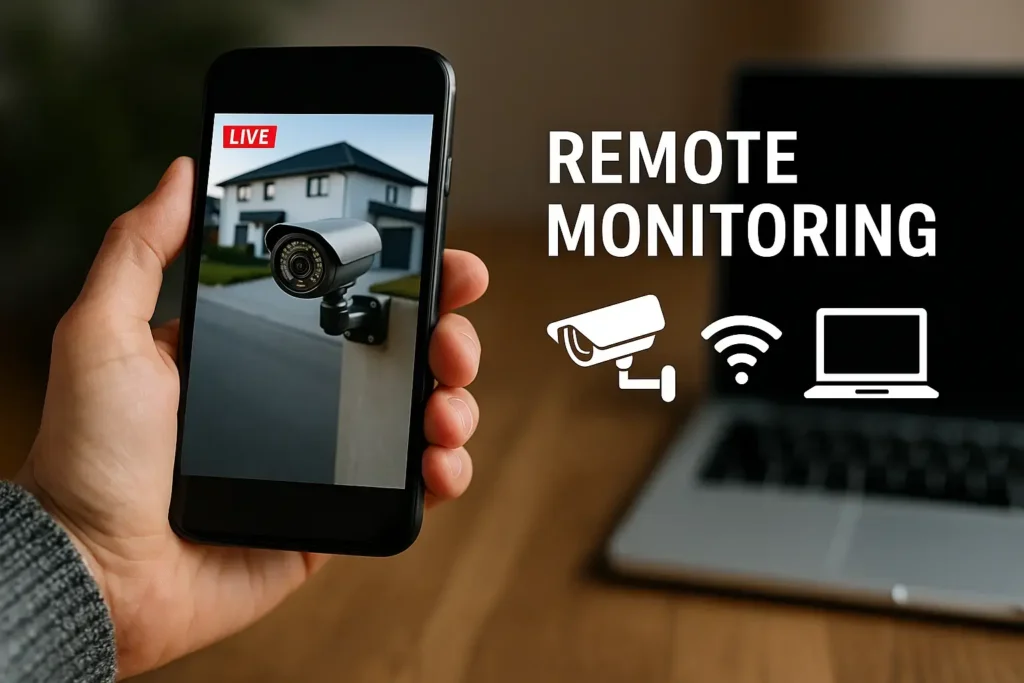
One of the biggest advancements in modern CCTV systems has been their ability to view footage remotely. This enables IP cameras to provide:
- Remote access
- Network connectivity
- Accessibility via mobile devices or computers
Home security cameras also allow remote viewing through smartphones and computers, so owners can keep an eye on their home from anywhere in the world. This capability is ideal for those who travel often or want to monitor their property in real-time when not at home.
Motion Detection
Motion detection in CCTV systems is designed to detect movement in the surveillance area so the home or business owner can get alerts and recordings of activity. These recordings are only initiated when motion is detected.
IP cameras that are used with motion detection allow the owner to view live and recorded footage remotely while storing videos on NVRs or in the cloud. This provides an extra layer of convenience and leads to a higher level of security.
Night Vision
Some Modern CCTV cameras feature infrared (IR) technology that allows them to work in low light. Night vision is key to surveillance when activities need to be monitored even in complete darkness.
Benefits and Challenges of CCTV (Pros and Cons)
While CCTV systems have many benefits that improve security and efficiency, they also have several challenges. Owners need to make sure their systems are working 24/7 to provide constant monitoring. In addition, professional monitoring must comply with privacy regulations in their particular town or state. There is also an ongoing issue around protecting personal data since these cameras are recording anyone who passes by.
While CCTV cameras create safer work environments and lead to a higher level of accountability among employees, they also raise privacy and ethical issues in the workplace. Other challenges of CCTV systems include high initial cost, technical issues and improper configuration.
Benefits of CCTV (Pros)
CCTV reduces the likelihood of property crime by serving as a deterrent to potential offenders who know they may be recorded. It also provides evidence for investigations to help enforcement solve crimes and prosecute.
Common Challenges (Cons)
While CCTV helps deter crimes and assist with investigations, there are also concerns about the use of this technology. These include:
- Potential intrusion on individuals’ privacy
- High cost of installation
- Complexity of network systems, which can have a steep learning curve and be vulnerable to hackers
- A tool used primarily forensically post-event, versus stopping a crime in real-time
CCTV systems are also vulnerable to external factors such as weather and tampering, which can affect their functionality. Addressing these issues requires continuous planning and companies need to perform regular maintenance.
Future Trends in CCTV Technology
The future of CCTV is being shaped by emerging trends and advancements that will enhance video surveillance systems. Modern CCTV can now integrate with other security systems for a holistic approach to surveillance. For example, advanced video content analysis through computer vision and AI-powered cameras is being used for access control and to regulate and monitor entry into specific areas based on object classification, facial recognition, or other criteria. AI-driven analytics and cloud-based solutions are expected to play a vital role in the future of CCTV.
As the technology continues to advance, CCTV will become more autonomous and proactive, with better image quality and more efficient storage. This will mean better threat assessment and faster response times, which will bolster security and potentially save lives.
Integration with AI
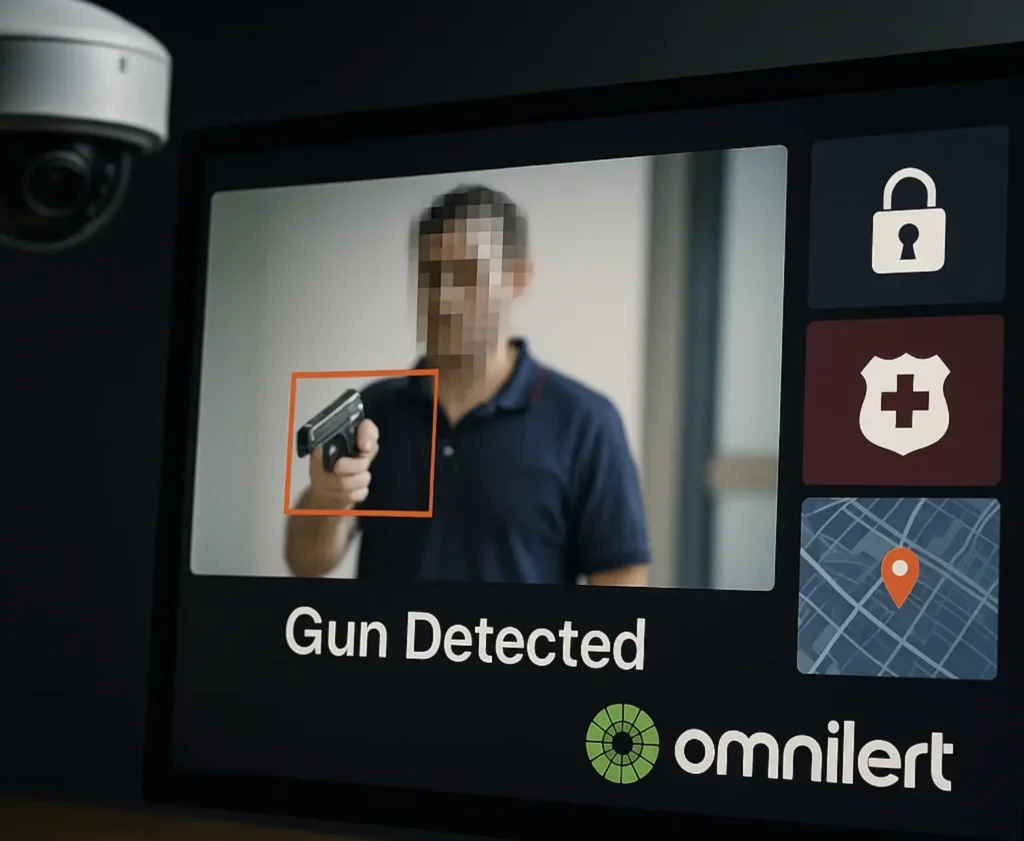
One of the most recent advancements that enhances the effectiveness of CCTV is the use of artificial intelligence (AI) technology. As an example, Omnilert has developed a proactive, AI-powered gun detection and automated response solution that enables existing security cameras to identify firearms the moment they are brandished. Once verified, the gun detection system initiates a rapid, multi-layered response that includes locking doors, alerting first responders and providing real-time intelligence. The technology also provides detailed situational intelligence so that first responders know exactly where to go, who to look for and what type of threat they face, ensuring a faster, more effective response.
Omnilert has also addressed the privacy concerns around its technology by ensuring that no facial recognition of subjects is ever monitored. The system can also be designed so video feeds never leave the premises, which is an important feature for institutions such as schools, hospitals and the government.
Another technology enabled by AI is behavioral analysis, which can detect loitering and trespassing and flag suspicious activity. Integrating technologies such as this and visual AI gun detection into CCTV systems makes them much more proactive and effective at monitoring and responding to threats.
Cloud-Based Storage
Cloud storage for CCTV footage provides scalable and flexible video data management. The video is stored securely and is easily accessible so the owner can monitor and review from anywhere, at any time.
The Future of CCTV
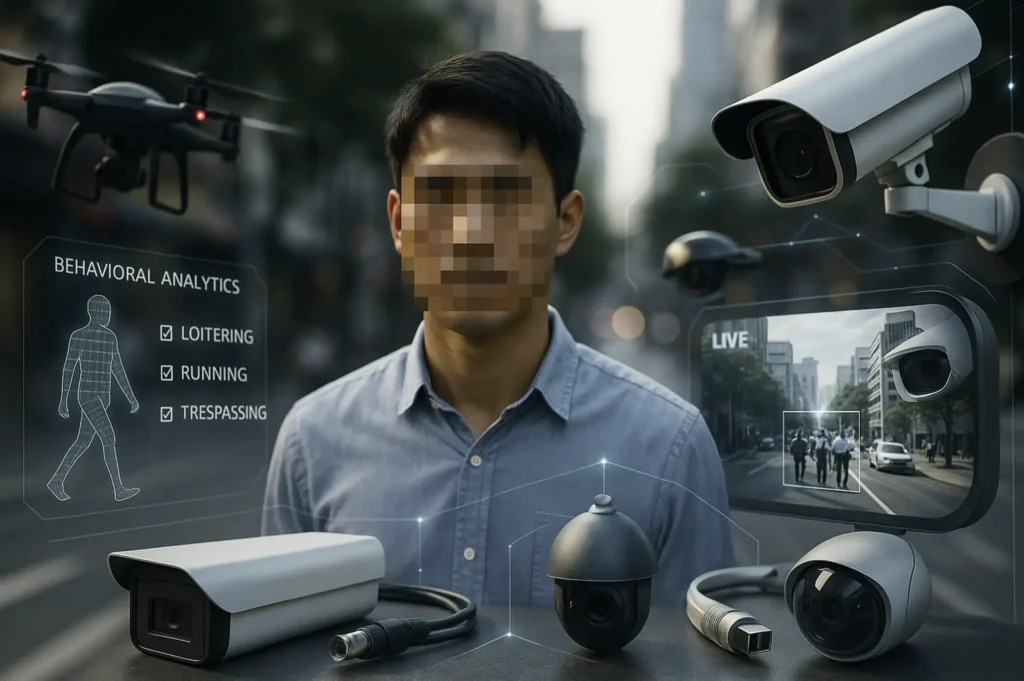
CCTV is a core part of modern security infrastructures with its ability to help deter crimes and provide evidence for investigations and prosecution. This technology has evolved significantly since its first introduction in the 1930s and has benefited greatly from technological advancements in camera quality, digitization, and storage. As we look to the future, AI will further enhance the effectiveness of these systems by enabling innovative new capabilities, such as visual AI gun detection and behavioral analysis, which can prevent crimes and save lives.
Frequently Asked Questions (FAQs)
What does CCTV mean?
CCTV stands for Closed-Circuit Television, a surveillance system where video signals are transmitted privately and not publicly.
How do CCTV systems work?
CCTV systems work by using cameras to capture video and then transmit the feed to monitors, where it is recorded for storage. This allows real-time monitoring and documentation of activities in multiple locations.
What are the types of CCTV cameras?
The three types of CCTV cameras are dome cameras, bullet cameras and IP cameras, each with different features to suit different surveillance needs. Choosing the right one is key to effective security monitoring.
What are the benefits of CCTV?
CCTV offers many benefits such as deterring crime, providing evidence for investigations, improving workplace safety and making employees more accountable.
What are the common issues with CCTV?
Common issues with CCTV are privacy concerns, high installation cost, technical issues and susceptibility to external factors such as weather and tampering. Addressing these is key to effective surveillance management, which is why companies such as Omnilert ensure that no facial recognition is used in its visual AI gun detection technology.



